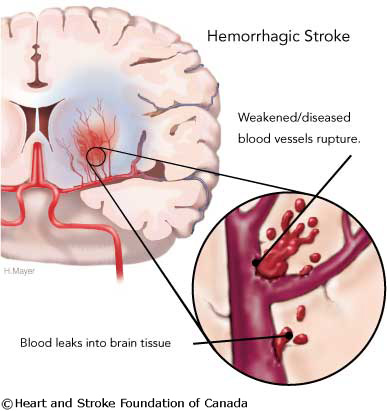 What Is A Stroke?
What Is A Stroke?
Stroke, sometimes called a "brain attack," is the number one cause of disability in the United States. It happens when the normal flow of blood to the brain is interrupted, having the potential to cause serious damaging effects on the body.
What Happens With A Stroke?
A stroke, or blockage of normal blood flow to the brain, can happen in two different ways:
- Ischemic Stroke. In ischemic stroke, blood clots or plaques build up in the blood vessels carrying blood to the brain. When your brain doesn't get enough blood, your brain cells begin to die rapidly. Ischemic strokes are the most common form of stroke.
- Hemorrhagic Stroke. This is also called a cerebral hemorrhage. It happens when a blood vessel ruptures and blood spills into the brain, killing brain cells. It is usually caused by high blood pressure or an aneurism. An aneruism is a weakened area of the blood vessel that balloons out and can rupture. It is less common than ischemic stroke, but can have devastating effects.
Signs & Symptoms Of Stroke
It's important to understand the signs of a stroke so you can take immediate action to prevent damage to the brain:
- A sudden numbness or weakness in one side of the body, specifically in the face, arm or leg.
- Severe headache with no known cause
- Dizziness and a loss of balance or coordination.
- Sudden confusion, trouble speaking or understanding
- Trouble seeing in one or both eyes
If you or someone you know experiences these symptoms, it may be a stroke or a mini-stroke, also known as a Transient Ischemic Attack (TIA). While this is not a full stroke, it should be taken seriously. One-third of people who have a mini-stroke will go on to have a stroke.
How To Diagnose A Stroke
The National Stroke Association recommends immediate action if you think someone is having a stroke. Here are some simple test for assessing if it is stroke:
- The Face. Ask the person to smile. Does one side of the face droop?
- The Arms. Ask to person to raise both arms. Does one arm drift downward?
- Speech. Ask the person to repeat a simple sentence. Are the words slurred and is the sentence repeated correctly?
If the answer to any of these questions is yes, time is critical. Call 9-1-1 or take the person to the hospital immediately.
Risk Factors For Stroke
While you can reduce your risk for stroke through lifestyle choices, there are certain uncontrollable factors that may put you at higher risk for stroke. These include:
- Age. You're at higher risk if you're if are over the age of 55.
- Gender. Men have a higher risk than women.
- Ethnicity. African American, Hispanic, Pacific Islander, Asian and South Asians are at risk.
- Family History. You should check into any relatives who may have suffered a stroke.
- Your Medical History. If you have had a mini-stroke, or TIA, in the past, you are at higher risk for having a full stroke.
Preventing Stroke
Even if you fall into a high risk group, there are actions you can take to reduce your chances of having a stroke. These include:
- Regular Check-Ups. Have your blood pressure checked every year. High blood pressure, or hypertension, is a major risk factor for stroke.
- Manage Stress. Stress can contribute to high blood pressure, which raises your risk of stroke.
- Diabetes. Get tested to see if you have diabetes. Diabetes accelerates blockages of your arteries and increases your risk of stroke.
- Smoking & Alcohol. Stop smoking and limit your alcohol intake.
- Cholesterol. Know your cholesterol numbers and make sure they are controlled.High cholesterol can clog your arties and keep blood from moving to the brain.
- Healthy Weight. Being overweight increases your stroke risk.
- Birth Control. Birth control pills can increase the risk of stroke, especially for women who are over 35, smoke, have high blood pressure, diabetes, or high cholesterol.
- Hormone Therapy. Women taking hormone replacement therapy may also be at higher risk for stroke.
Treating Stroke
There are several different ways to treat a stroke. These include:
Medications
These types of medications are usually prescribed for ischemic strokes:
- Clot-Busting Drugs. These drugs must be given within three hours of the start of a stroke in order to work.
- Anticoagulants, or Anti-Platelet Agents. These medications, like aspirin, may be prescribed to prevent a second stroke from happening.
Surgery
Surgery may be an option if you've had a hemorrhagic stroke. Carotid endarterectomy and angioplasty are two possible surgical procedures. Aneurysm clipping can prevent an aneurysm from re-opening and bleeding into the brain.
Rehabilitation
After a stroke, many of your body's functions may be affected. Rehabilitation can help restore basic abilities. Your plan may include:
- Physical Therapy. This can help with movement, balance and coordination.
- Occupational Therapy. This may be recommended for relearning skills like dressing and bathing.
- Speech Therapy. This may be used for re-learning how to talk.
- Dietician. A professional can help you make healthier food choices to prevent a second stroke.
- Social Worker or Psychologist. These professionals may help you get back on your feet emotionally.
Remember, reducing the damaging effects of stroke can be prevented though healthy lifestyle choices and acting fast if a stroke happens.
 What Is A Stroke?
What Is A Stroke?
0 Response to "Stroke"
Post a Comment